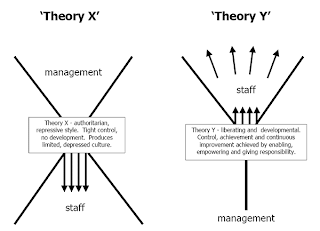In my previous Blog, I referred to some basic principles of
Organisational Management which were covered in the first lecture of Principles
of Organisational Management by Dr T.Prasad aka Dr.Mandi. Moving forward, let’s get some
insights of what we learnt in the second lecture of the course which focussed
on two theories of Organisational Management THEORY X and THEORY Y:
Objectives:
The objective of this Blog is to
understand the underlying concepts of THEORY X and THEORY Y which are related
to the theory of human motivation. I will
be covering these concepts by first explaining these theories, comparing them
and then defining what implication these theories have on organisations.
THEORY X and THEORY
Y:
Theory X and Theory Y are theories of
human motivation created and developed by Douglas McGregor at the MIT Sloan School of Management in the 1960s that have been used in human resource management, organizational
behaviour, and organizational
development. They describe two very different
attitudes toward workforce motivation. McGregor felt that all companies
followed either one or the other approach.
To understand these theories better, let’s make the following
assumption:
Theory X:
In this theory, management assumes employees are inherently lazy and will avoid work if they can and that they inherently dislike work. As a result of this, management believes that workers need to be closely supervised and various policies are developed to control them. Theory X managers think that employees main motivation is to work for money and hence incentives are included according to work done.
Theory Y:
In this theory, management assumes
that employees are happy to work, are self-motivated and creative, and enjoy
working with greater responsibility. In Y-Type organizations, people at lower
levels of the organization are involved in decision making and have more
responsibility. Managers provide a comfortable woking environment to the employees.
To understand this theory better please watch this video:
By now, you would have got a fair idea about Theory X and
Theory Y. Now, try to test your understanding by analysing the below mentioned
statements. What can you deduce by reading each of these statements?
1- Theory X: Manager assumes LAZY workers as LAZY and makes them work .
2 -
Theory X: Manager assumes NOT LAZY workers as LAZY and makes them work.
3 - Theory Y: Manager assumes LAZY workers as NOT LAZY and makes them work.
4 - Theory Y: Manager assumes NOT LAZY workers as NOT LAZY and makes them work.
3 - Theory Y: Manager assumes LAZY workers as NOT LAZY and makes them work.
4 - Theory Y: Manager assumes NOT LAZY workers as NOT LAZY and makes them work.
Let’s discuss these statements
and their implications on organisation one by one:
1- Theory X: Manager assumes LAZY workers as LAZY and makes them work .
In this case people are already lazy/not working, if they are not controlled, productivity will keep falling which is not good for an organisation. So, more control of management will lead to some increase in productivity which leads to
better results.
2 - Theory X: Manager assumes NOT LAZY workers as LAZY and makes them work.
This is a case where hard working workers are treated as lazy
workers, this leads to de-motivation of the hard working employee. It also
leads to conflict between worker and manager which ultimately results in decrease
in productivity of the organisation.
3 - Theory Y: Manager assumes LAZY workers as NOT LAZY and makes them work.
This is one of the most dangerous situations wherein the
employees are Lazy but the management thinks they are hard working. There is
not much control exercised over employees which results in much more decrease
in productivity. Also, it leads to de-motivation of those employees who work
hard as they are paid equal to those who are not working properly.
4 - Theory Y: Manager assumes NOT LAZY workers as NOT LAZY and makes them work.
This is the best
situation which can exist in an organisation. In this case, employees seek and accept responsibility and do not need much direction. They
are motivated to fulfil the goals that are given to them. This leads to
better results and better productivity which leads to timely achievement of
organisations Goals.
I hope this explains THEORY X and THEORY Y to an extent. Please understand that different members of a team may have different attitudes. Many may thrive on Theory Y management,
while others may need Theory X management.
With this i conclude my blog on THEORY X and THEORY Y.
Please give your valuable feedback in comments section.



Good going Shahbaz.. Theory X and Theory Y for Organisational Management are the best Example between the management and Employees.. which we face in our daily life..
ReplyDeleteFor this, If Manager is not baised and ofcourse not Lazy then there may be a different theory...
Indeed better management leads to better result!
ReplyDelete